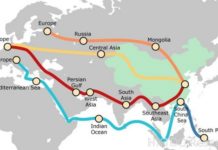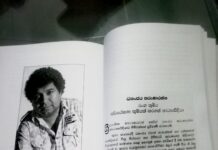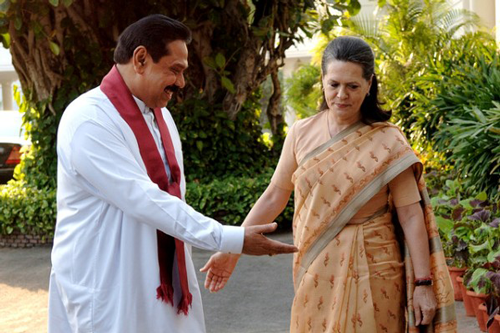හැඳින්වීම
සෑම් රාජප්පා විසින් රචිත උතුරේ යුද්ධය පිළිබඳ රචනාව කියවන විට (එය වෙනත් තැනක පළ වී ඇත) එය මේ දක්වා යුද්ධය ගැන පළ වූ විවිධ විචාර ටීකා ටිප්පනිවලින් එක ‛සාධකයක්’ නිසා වෙනස් වෙයි. බොහෝදෙනා මෙතෙක් කල් යුද්ධය විචාරය කරනු ලැබුවේ එක්කෝ වාස්තවික කරුණු පදනම් කරගෙනය (යුද බලය, තාක්ෂණය, පිරිස් බලය, උපායික අවි, මුහුදු බලය සහ ගුවන් බලය, මහින්ද චින්තන විදේශ ප්රතිපත්තිය, තොරතුරු තාක්ෂණය… ආදිය). නැතහොත් විවිධ මනෝබද්ධ සාධක පදනම් කරගෙනය (මහින්ද රාජපක්ෂගේ සහ සරත් ෆොන්සේකාගේ උපායික ඥානය). නමුත් රාජප්පාගේ විග්රහය ඉහත අන්තයන් දෙකම අතහැර ඊට විකල්පයක් යෝජනා කරයි. ඔහු මේ සඳහා යෝජනා කරන වචනය වන්නේ Vendetta (පවුල් අතර බද්ධ වෛරය, මැරුම් කෑ අයගේ පවුලේ අය මරා දැමූවන්ගේ පවුලේ අයගෙන් පලිගැනීමේ යෙදීම) නොහොත් ‛ඉතාලි බද්ධ වෛරයයි’. අවසාන විග්රහයකදී සෑම් රාජප්පා අපට පෙන්වා දෙන්නේ දේශපාලනය (politics) සහ සදාචාරය[ Ethics – මිනිසෙකුගේ හැසිරීමක් මගින් ජන සමාජයකට සදාචාරාත්මක නිර්ණයක් ලැබේද යන ප්රශ්නය] අතර පෑස්සිය නොහැකි පරතරයයි (Gap)
යථාර්ථයේ ප්රබන්ධ ස්වභාවය වටහා ගැනීම
ජොනතන් ඩෙමී විසින් අධ්යක්ෂණය කළ ලෝකය පුරා ඉතා ජනප්රිය වූ රහස් පරීක්ෂක ෂානරයේ චිත්රපටියක් වූයේ The Silence of the Lambs (1991) ය. මෙම චිත්රපටය රහස් පරීක්ෂක නාටකයක් පමණක් ලෙස සලකන්නේ නම් එහි ආරම්භක අවස්ථාවේදී අප මිනීමරුවා කවුද කියා නොදන්නෙමු. නමුත් චිත්රපටය අවසානයට යන විට බෆලෝ බිල් නම් ‛අනුක්රමික මිනීමරුවා’ කවුදැයි අපි හඳුනා ගනියි. ඒ අනුව චිත්රපටය අවිද්යාවෙන් ආරම්භ වී ප්රඥාවෙන් කෙළවර වෙයි. නමුත් මේ අදහස මගින් විදාරණය වන්නේ චිත්රපටයේ කොටසක් පමණි. චිත්රපටය මගින් අපගේ ආශාව තහවුරු වන වගට විවාදයක් නැත. චිත්රපටය හරහා අපගේ ආශාවේ සුක්කානම කරකවන්නේ අපම බව ද තහවුරු වෙයි. එසේ නමුත් චිත්රපටයේ තවත් අර්ධයක් ආශාව තහවුරු වීම හරහා විග්රහ කළ නොහැකිය. මෙම චිත්රපටය නරඹා අපගේ ආශාවේ ස්වාමියා අපම යැයි කියා කිව නොහැකි ආචරණයක් ද ඇත. චිත්රපටය නරඹමින් ටික වෙලාවක් යන විට චිත්රපටයේ තවත් භූමිකාවක් වන ආචාර්ය හැනිබාල් ලෙක්ටර් නම් චරිතය සමඟ අපගේ ආශාව අනන්ය වන බව අපට වැටහේ. මිනීමරුවෙකු සමඟ අනන්ය වීම නිසා ප්රේක්ෂිකාව එක අතකින් අසහනයට ද පත්වෙයි. අනෙක් අතට එවන් අනන්යවීමක් හරහා සදාචාර ප්රශ්නයක් ද මතුවෙයි. එමගින් මතුකරන ගැටලුව වන්නේ මිනීමරුවෙකු ‛හොඳ’ මිනිසකු ද යන්නය. මෙම උභතෝකෝටිකය නිසා ප්රබන්ධ චරිතය සහ ප්රේක්ෂිකාව අතර පරතරය බිඳ වැටෙයි. චිත්රපටයේ එක්තරා අවස්ථාවකදී ලෙක්ටර් මෙසේ පවසයි. ‛මට අද රාත්රියේ පරණ යාළුවෙකුගේ මොළයක් කන්න තියෙනව’ (යුද ජයග්රහණය ලැබූ මොහොතට පසු රාජ්ය රූපවාහිනී නාලිකාවක් සමඟ සම්මුඛ සාකච්ඡාවක් පැවැත්වූ ජනරාල් ෆොන්සේකා මෙසේ පැවසීය. ‛මම ත්රස්තවාදීන්ගේ සියල්ල විනාශ කළා. කුඩා බඩවැල්, මහ බඩවැල්… එහිදී ද ප්රේක්ෂක ප්රතිචාර ඉහළ විය) මෙම වාක්යය සඳහා ප්රේක්ෂකයන්ගෙන් එල්ල වූයේ ඝෝෂාකාරී අත්පොළසන් නාදයකි. මෙම වාක්ය හරහා හැනිබාල් ලෙක්ටර් මෙන්ම ප්රේක්ෂකයන් ද යම් සතුටක් ආරෝපණය කර ගනියි. මන්දයත් එම යෙදුම උභයාර්ථ නිසාය. මෙතැන අපට හමුවන සත්යයේ මානය කුමක්ද? මන්ද ලෙක්ටර්ගේ ආශාවත්, ප්රේක්ෂකයන්ගේ ආශාවත් එකිනෙකට සමපාත වීම යනු ලෙක්ටර්ගේ විනෝද වීම, ප්රේක්ෂකයන්ගේ විනෝද වීම සමඟ සමපාත වීම වන නිසාය. සිනමාව තුළදී පවා මෙවැනි විනෝදවීමක් සම්මුඛ වීම දුර්ලභ අත්දැකීමකි. මෙම දුර්ලභ අත්දැකීම මගින් අපත් හැනිබාල් ලෙක්ටර් මෙන් මිනීමරුවෙකු වන නිසා එමගින් ඇති කරන්නේ තිගැස්මකි. මන්දයත් මෙය පොදු සමාජයේ සදාචාරයට ප්රතිවිරුද්ධ වන නිසාය. (නීතියට අනුව මිනීමැරීම තහනම්ය. එය දඬුවම් ලැබිය යුතු වරදකි.)
මනෝවිශ්ලේෂණය මගින් අපට උගන්වන පාඩමක් නැවත පුනරීක්ෂණය කිරීම මෙතැනදී වැදගත්ය. හැනිබාල් ලෙක්ටර් නම් ඝාතකයා සමඟ අප අනන්ය වීමේදී අප ලබන අසමසම අත්දැකීම වන්නේ ඒ හරහා අප අනන්ය වන්නේ අනන්යකරණයට එහායින් ඇති පතුලක් නැති ළිඳකට වීමයි. උදාහරණයක් ලෙස හැනිබාල් ලෙක්ටර්ගේ සයිකෝසියාවත් ඉන් අදහස් වන ප්රහේලිකාවත් ‛බැටළුවන්ගේ නිහඬ වෘතය’ වන චිත්රපටයත් යන මේ සියල්ල යනු දෘශ්යමානයන්ය (appearances). මේ දෘශ්යමානයන් යටින් අර්ථාන්විත කිසිවක් නැත. ලෙක්ටර්ගේ වෙස්මුහුණ යට දයාබර මානුෂික හදවතක් හෝ කෲර ඝාතකයෙක් නැත. ලෙක්ටර්ගේ ප්රහේළිකාව යනුවෙන් ප්රපංචයක් බිහිවන්නේම ලෙක්ටර් වැනි චරිතයක් සමඟ අප අනන්ය වන නිසාය. අපගේ අනන්යකරණයන්ගෙන් පිටත හැනිබාල් යනුවෙන් කෙනෙක් නැත. එබැවින් හැනිබාල් ලෙක්ටර් යනු ප්රේක්ෂක අපගේම අභ්යන්තරය පිටතට යාමකි. ‛අපේකම’ අපටම ආගන්තුකය.
ජාතික ගැටලුවට මාක්ස් සහෝදරයන්ගේ විසඳුම
පොදුවේ ගත් කල දකුණු ආසියාවේත්, සුවිශේෂව ගත් කල ශ්රී ලංකාවේත් මූලික දේශපාලන ගැටලුව වන්නේ සමාජ දේහයේ නූතන ධනවාදය මගින් සිදුවන විශාල විපර්යාසයන් වටහා ගැනීමේ කිසිදු බුද්ධිමය ශක්යතාවයක් නැති පවුල්වාදයක් විසින් සමාජ ගැටලු විසඳීමට යාමයි. එක පැත්තකින් මේ පවුල්වාදය යටත්විජිතවාදයේ නෂ්ටාවශේෂයකි. අනෙක් පසින් නූතන ධනවාදය ද මෙම පවුල්වාදී දේශපාලන ආකෘතිය ලෞකිකකරණය කරයි. සමාජයේ මධ්යය සඳහා පැරණි ගතානුගතික සමාජය තුළ ආදේශ වී පැවතියේ දෙවියන් සහ ඔහුගේ ආවතේවකරුවන්ය. රජතුමා යනු ද ආවතේවකරුවෙකි. නූතන දකුණු ආසියානු සමාජ මධ්යයට දැන් ආදේශ වී ඇත්තේ ලෞකිකකරණය වූ දෙවියෙකි. එබැවින් මෙම කලාපයේ දේශපාලන සංකල්ප යනු ලෞකිකකරණය වූ දේවධාර්මික සංකල්පයන්ය.
නූතන සමාජය තුළ මෙම ලෞකිකකරණය වූ දේවධාර්මික සංකල්ප ක්රියාත්මක වන ආකාරය විභාග කරමු. 20 වන සියවසේ මුල ඇමරිකානු හොලිවුඩ් සිනමාවේ හාස්ය රසය බිහි කළ පුරෝගාමීන් වූයේ චාලි චැප්ලින් සහ මාක්ස් සහෝදරයන්ය. මින් මාක්ස් සහෝදරයන් තිදෙනෙකුගේ චර්යාවන් නූතන පාලන සංස්කෘතිය තුළ අවිඥානක අධිනිශ්චය1 වී ඇත. ඔවුන්ව නමින් සහ ක්රියාවෙන් මෙසේ හැඳින්විය හැකිය. ග්රව්චෝ මාක්ස්. මොහු මගින් නිරූපණය වන්නේ සුපිරි අහමයි. ඔහු ඉතා ජනප්රිය වන අතර ජීවිතය සතුටෙන් ගත කරන්න යන නියෝගය ලබාදෙයි. එබැවින් ග්රව්චෝ මාක්ස් ජීවිතයේ සිට නගරය දක්වා සියල්ල සුන්දරකරණය කරයි. ඊළඟට චිකෝ මාක්ස්. ඔහු මගින් නිරූපණය වන්නේ අහමයි. ඔහු සෑම දෙයක්ම කිරා මැන බලයි. සෑම දෙයක් දෙසම උපයෝගිතාවාදී දෘෂ්ටිකෝණයෙන් නරඹයි. සබුද්ධිකව ආර්ථික ක්රියා පාලනය කරයි. අවශ්ය අයට කප්පම් ගෙවයි. අවසානයට හාර්පෝ මාක්ස්. ඔහු මගින් නිරූපණය වන්නේ අවිඥානයයි. අහිංසක ළමයෙකුගේ හදවතක් ඇති හාර්පෝ විටෙක කිසිදු හේතුවක් නැතිව යක්ෂාවේශ වෙයි. තවත් විටෙක අධික ලෙස පිරිසිදුකම ගැන කතා කර අන්ත දූෂණයක් කරයි. මාක්ස් සහෝදරයන්ගේ පාලනය ගැන අපට කිවහැක්කේ කුමක්ද? බඩ අල්ලාගෙන හිනාවෙනවා හැර වෙන කරන්නට දෙයක් නැත. සෝනියා ගාන්ධිගේ පවුලේ බද්ධ වෛරය අවසන් වූයේ ලංකාවේදී ඇයට අනුක්රමික මිනීමරුවන් හමුවීමෙනි. ඒ නිසාම කොංග්රස් පක්ෂය අන්ත දූෂණයට ලක් වූ අතර විශාල ජන ඝාතනයක අවිඥානක කේන්ද්රය බවට ඇය පත්විය. සිංහල සහ දෙමළ සමාජයට තමන්ව පාලනය කිරීමට මාක්ස් සහෝදරයන් හමුවිය. නමුත් ‛ජාතික ගැටලුව’ නම් දේශපාලන ප්රශ්නය තවම විසඳී නැත∎
දීප්ති කුමාර ගුණරත්න
Sonia Gandhi wanted Colombo to decimate LTTE without finalising a Political Solution
by Sam Rajappa
THE Sri Lankan High Commissioner to India, Prasad Kariyawasam, now in Colombo for consultations, has sought an appointment with the Tamil Nadu Chief Minister, Jayalalitha, in Chennai to extend to her a personal invitation from President Mahinda Rajapaksa to visit Sri Lanka. In its attempt to pamper Rajapaksa to serve the agenda of Congress president Sonia Gandhi, India had betrayed the cause of Sri Lankan Tamils who have been struggling for equal rights with the majority Sinhalese.
David Miliband and Bernard Kouchner, former foreign ministers of Britain and France respectively, after a recent visit to Sri Lanka, wrote: “Tamil life is treated as fourth or fifth class citizens. If foreign policy is about anything, it should be about stopping this kind of inhumanity.”
South Block remaining a silent spectator, Chennai has wrested the initiative and Rajapaksa is worried. When the Tamil Nadu Assembly passed a resolution seeking retrieval of Kachchatheevu, a part of Ramanathapuram district which Indira Gandhi illegally ceded to Sri Lanka in 1974, and urged the Centre to call upon the UN to investigate war crimes against Rajapaksa, Colombo dismissed the whole thing as the rantings of a Chief Minister who has no locus standi on foreign affairs.
Even our own external affairs ministry which gave scant regard to public sentiments in Tamil Nadu while gifting Kachchtheevu to Sri Lanka or while fishermen from the State were being shot dead like wanton flies by the Lankan navy seems to have undergone a sea change after Jayalalitha’s assumption of office in Fort St. George. Foreign secretary Nirupama Rao told a group of Sri Lankan journalists visiting New Delhi last week “the Indian government can no longer remain insensitive to the sentiments expressed by the Tamil Nadu government, the politicians and the people of Tamil Nadu about the issues affecting the Tamils in Sri Lanka.”
The screening of Channel 4’s “Killing fields of Sri Lanka” by a national television channel for three consecutive days last week showing naked Tamil prisoners shot in the head, dead bodies of women who had been raped and dumped on a truck, the immediate aftermath of shells landing on a hospital in a ‘no fire zone’ and the atrocities committed by the Sri Lankan armed forces in the final moments of the brutal civil war have left the people nauseated and shell-shocked.
The authenticity of the footage has been confirmed by a forensic pathologist, forensic video analyst, firearms evidence expert and a forensic video expert of international repute. Channel 4’s senior news executive Dorothy Byrne had cautioned viewers not to watch the programme saying “it is horrific, the images will remain in your mind may be for years.” The 53-minute footage is being dubbed in Tamil to be screened by Jaya TV owned by Jayalalitha in the next few days. Already Tamil Nadu is on the boil for India’s contribution to the genocide Sri Lanka.
There is an untold story about how New Delhi became instrumental in the brutality brought out in the Channel 4 documentary. India was hoping for the victory of Ranil Wickremasinghe of the UNP with whom our then High Commissioner in Colombo, Nirupama Rao, had established a close relationship, in the 2005 presidential election. Rajapaksa of the SLFP, a known hawk, won by the narrowest of margins, as President. Had it not been the boycott of the election by the Tamils in response to a call given by the LTTE, Wickremasinghe would have won easily. Rajapaksa wanted to outlive his image of a hawk and establish rapport with the Indian political leadership but New Delhi repeatedly rebuffed him.
This made him realise the importance of involving civil society in Tamil Nadu to resolve the intractable ethnic problem in his country. His emissaries were scouting for a group in Tamil Nadu who could act as a bridge between the two countries. After much persuasion by Colombo, a small four-member group comprising MG Devasahayam, a former IAS officer and close associate of Jayaprakash Narayan and Mother Teresa as convenor, SP Ambrose, retired IAS officer who was home secretary of Tamil Nadu and Secretary to Government of India, a senior journalist working for a national daily, and a military veteran well versed in Sri Lankan affairs was formed and held its preliminary meeting in Chennai on 10 May 2007, with Sunimal Fernando, adviser to President Rajapaksa, participating. It was unanimously agreed that a military victory for one side without a political strategy to address the grievances of the Tamil community was unlikely to produce a lasting solution to the ethnic crisis.
The group had its first meeting with President Rajapaksa and his team comprising Lalith Weeratunga, secretary to the President, assistant secretary Waruna Sri Dhanapala and adviser Fernando in Colombo on 17 July 2007. Throughout the two-hour discussions, Rajapaksa gave the impression that he was not unduly worried about international criticism of his regime but was greatly concerned about Indian opinion. He fully endorsed the group’s opinion expressed by Devasahayam that the solution to the crisis should emerge from within Sri Lanka and refined through international opinion, particularly from India.
After the two-day meetings with the Tamil Nadu group, Rajapaksa said at a public function “we ought to be sensitive and responsive to the genuine grievances of the people in the North-East,” traditional homeland of the Sri Lankan Tamils.
To cut a long story short, the Tamil Nadu civil society group had a series of meetings with Rajapaksa’s team of officials and ministers in Sri Lanka and Chennai to carry forward the progress made so far and agreed upon many steps to resolve the conflict. A crucial conference was held with President Rajapaksa in Colombo on 25 March 2008, followed by a series of meetings with DEW Gunasekara, Sri Lankan Minister for Constitutional Affairs and National Integration, Raja Collure, chairman of official language commission, and others for evolving a political solution and confidence-building measures. An action agenda was set.
The Indian High Commission in Colombo got wind of the Tamil Nadu group’s activities and the Deputy High Commissioner, A Manickam, sought an appointment with Devasahayam. It was fixed at 5 p.m. at the hotel he was staying which was next door to Manickam’s office.
Manickam never kept his appointment but the High Commission later reprimanded the Sri Lankan presidential team for holding peace talks with ‘unauthorised’ persons. The civil society initiative was conveyed to Sonia Gandhi by a Congress member of the Lok Sabha from Tamil Nadu who was trying to sell the idea of panchayat raj system to Rajapaksa to resolve the ethnic crisis.
Unaware of these developments in New Delhi, Devasahayam wrote to TKA Nair, one of his former colleagues who was occupying the post of principal secretary to Prime Minister Manmohan Singh, on 1 April 2008, recalling the Indian defence ministry’s annual report to Parliament which said: “We strongly believe that there is no military solution. What is required is a settlement of the political, constitutional and other issues within the framework of a united Sri Lanka which addresses the concerns of all communities, especially that of the ethnic minority.”
Devasahayam outlined the progress made by the Tamil Nadu group and the action agenda that had been set. The letter regretted that government of India, while providing Sri Lanka with weapons systems and training facilities, remained indifferent to activating any peaceful negotiated settlement. It requested the government to support the initiative taken by the Tamil Nadu group to end the long-festering humanitarian crisis. The letter remains unanswered to this day.
It was after this group’s successful initiative that India changed track and gave the green signal to the Sri Lankan government to go all out to decimate the LTTE without insisting on a political solution to resolve the ethnic crisis. According to sources in Colombo, Sonia Gandhi wanted LTTE leader Velupillai Pirapaharan and its intelligence chief Pottu Amman decapitated and pledged all military support to Sri Lanka to achieve her goal.
The then national security adviser MK Narayanan, foreign secretary Shivshankar Menon and the clique controlling the Prime Minister’s Office put Sonia Gandhi’s interest above national interest and actively assisted the brutal Sri Lankan genocide that could be seen in the Channel 4 documentary thus creating the quagmire Sri Lanka finds itself in. This is evident from the fact that while the whole world is seething at what they saw in the documentary, the government of India is deafeningly silent.
There is every possibility of Rajapaksa and company being hauled up before the International Court of Justice at The Hague to stand trial for war crimes and genocide. In the event, New Delhi cannot escape responsibility for this horrendous brutality. The bell is tolling.





















“මේ දෘශ්යමානයන් යටින් අර්ථාන්විත කිසිවක් නැත”
දකින දෙයට එහා කිසිවක් නැ කිවිවත් Cartesio (Rene’ Decarts) ගේ සැක කරිම පදනම් කර ගත් සිතිම විසින් අපට බල කර සිටිනව නේද යමි සැගවුනු අර්ථයක් දෘශ්යමානයයට එපිටින් ඇති බව.
තවද ඇත්තටම හැනිබාල් කෙනෙක් අප තුල පවතින්නේද නොදන්නා හැනිබාල් නිසා නේද.දෘශ්යමානය නඩත්තු කිරිමට නොදන්නා දෙයක් පරිකල්පනය කිරිම.(Cartesian formal object හො Kantian Noumeno)
අවසානයේ දිප්ති මෙහෙම කියමින් ඉහත අදහස තහවුරු කරනවා එනමි. ..”එබැවින් හැනිබාල් ලෙක්ටර් යනු ප්රේක්ෂක අපගේම අභ්යන්තරය පිටතට යාමකි. ‛අපේකම’ අපටම ආගන්තුකය. ඔවි අපිට අපේම අභ්යන්තරය ආගන්තුකයි ,ඇයි එහෙම වෙන්නෙ අපි විසින් සමස්ථය දෙකට කඩනවා දන්නා සහ නොදන්නා දෙය ලෙස. දන්නා දෙය නොදන්නා දෙය මත පවති. ඒ කන්ඩනය නිසාම නේද අපි නිපදවපු දෙය අපටම ආගන්තුක? නොදන්නා දෙය එහෙම නැත්නමි සැගවුනු දෙය විසින් දන්නා දෙය එනමි දෘශ්යමානය නිපදවනවා යයි සිතයි.
මට මෙතනදි දිප්තිගෙ අදහස සමග කිසිම ප්ර්තිවිරොදයක් නොමැත.ඔහුගෙ අදහස තහවුරු කිරමක් බටහිර අර්ථයෙන් “COERENZIAZIONE”
Comments are closed.